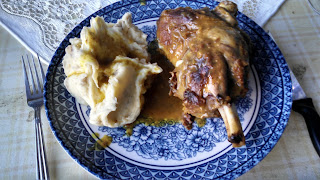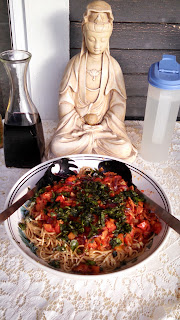Pancetta is a pork product very popular in Italy. In some circles it’s called Italian bacon. Along with prosciutto, it’s very common in the Italian kitchen. It is made from pork meat that is salt cured and spiced with lots of black pepper. In a the supermarket or deli it comes in a tight roll (arrotolata), or already cubed. It can even be found sliced paper thin.
If you can’t find pancetta, bacon can be substituted—but it won’t taste the same. Also, with bacon, it’s best to blanch it first in boiling water since it reduces its smoky flavor (pancetta is not a smoked product). That being said, the recipe given below can be done with almost any pasta but it’s usually served with spaghetti or linguini. Once in a while, if I’m feeling adventurous, I’ll use perciatelli, my favorite string pasta. Why? It’s thick, like a phone cable—and I love what my Uncle Phillip in pre-PC days would call a “manly pasta.”
One additional thing I must say, since we’re talking about pasta: remember in the old days when it came in one pound boxes? More and more it’s now 12 ounces. When did this crap start? Ronzoni, bless their heart, still comes in one pound boxes. Barilla does not (it’s 13.25 ounces). Everyone else, these days, is 12 ounces. Pretty soon it’ll be 9 ounces, then 8 . . . you get the idea. Someday a family of four will have to buy two boxes of spaghetti or whatever to get fed. If you’re lucky enough to find a place that sells fresh pasta, you can still get it by the pound—and even if it’s more expensive, it’s a better deal. The corporate structure (no surprise!) is out to gyp us.
I pound tomatoes (preferably plum tomatoes)
10-8 ounces pancetta or lean bacon, sliced
3 tablespoons olive oil
1 medium onion, thinly sliced
1 clove garlic, peeled and finely minced
1 pound fresh or dried spaghetti or linguini (if you can find a 1-pound box)
5 fresh marjoram sprigs, minced, or 1/4 teaspoon dried
Salt and ground black pepper to taste
1/4 cup fresh shredded basil
Freshly grated Pecorino or Romano cheese
1. Wash tomatoes under cold running water and pat dry with paper towels. Chop coarsely.
2. Heat olive oil in a medium saucepan. Add pancetta and stir-fry over low heat until fat is rendered.
3. Stir in onion and cook gently for 8 minutes. Add garlic and cook 2-3 minutes more.
4. Add tomatoes. Season with salt and pepper. Cook, uncovered for about 10 minutes, stirring well. Meanwhile, cook pasta according to package instructions.
5. Stir the marjoram into the sauce. Remove from heat. Drain the pasta into a serving bowl. Pour the sauce over the pasta and toss well. Sprinkle with shredded basil, and serve, passing around the Pecorino or Romano cheese.
Yield: 4 servings.
 Coquito is what my folks called Puerto Rican moonshine. And they were not too far off the mark. Coquito is a made at home in the traditional way, mainly for special gatherings. Some people liken coquito to potent homemade eggnog. And it can be very strong, or very mild, depending on how much rum you put into it.
Coquito is what my folks called Puerto Rican moonshine. And they were not too far off the mark. Coquito is a made at home in the traditional way, mainly for special gatherings. Some people liken coquito to potent homemade eggnog. And it can be very strong, or very mild, depending on how much rum you put into it. Mofongo, I love the word. It’s pronounced just like it’s spelled. A popular Caribbean dish but undoubtedly of African origin. Basic mofongo is simply a mixture of crushed plantains with fried pork crackling served with a sauce. In the Puerto Rican version, we prepare it as individually shaped mofongo balls, similar to meatballs. Cuban mofongo differs in that the mixture is shaped into one large ball which is served in a bowl. More modern variations have this type of mofongo stuffed with beef or seafood. Whatever method you prefer, it is a delicious appetizer, side dish, or meal on its own.
Mofongo, I love the word. It’s pronounced just like it’s spelled. A popular Caribbean dish but undoubtedly of African origin. Basic mofongo is simply a mixture of crushed plantains with fried pork crackling served with a sauce. In the Puerto Rican version, we prepare it as individually shaped mofongo balls, similar to meatballs. Cuban mofongo differs in that the mixture is shaped into one large ball which is served in a bowl. More modern variations have this type of mofongo stuffed with beef or seafood. Whatever method you prefer, it is a delicious appetizer, side dish, or meal on its own. I do not know what salmorejo means. Neither does anyone else in my family. My Uncle Carlos surmised that it was a word native to Puerto Rico that can be roughly translated as a “salad.” Perhaps. There are many crab salmorejo recipes. In some instances, sweet chili and capers are added. Our version is simple and no nonsense. The only liberty I’ve taken is in adding a little white wine. May not be exactly criollo*, but it supplies a bit of dash.
I do not know what salmorejo means. Neither does anyone else in my family. My Uncle Carlos surmised that it was a word native to Puerto Rico that can be roughly translated as a “salad.” Perhaps. There are many crab salmorejo recipes. In some instances, sweet chili and capers are added. Our version is simple and no nonsense. The only liberty I’ve taken is in adding a little white wine. May not be exactly criollo*, but it supplies a bit of dash. This dish came along, like many others through experimentation and the process of experimentation doesn’t have to stop here. Fresh parsley can be substituted for the cilantro, if you want a less defined taste. Some folks prefer fresh lemon juice in place of the vinegar. Again, let your palate be your guide. Traditionally, we serve fish steaks with root plants (bianda) or boiled green bananas (guineos).
This dish came along, like many others through experimentation and the process of experimentation doesn’t have to stop here. Fresh parsley can be substituted for the cilantro, if you want a less defined taste. Some folks prefer fresh lemon juice in place of the vinegar. Again, let your palate be your guide. Traditionally, we serve fish steaks with root plants (bianda) or boiled green bananas (guineos). Pasteles are a singular creation made from common ingredients: root plants stuffed with meat. The meat is usually pork, but it can also be chicken or turkey. At home it’s prepared only on the most special occasions. When I returned home from Vietnam this was the first dish my mother made on honor of my arrival. If you’re traditional you have to use plantain leaves to wrap the thing. If they can’t be found, then wax paper will do. Plantain leaves are abundant in Caribbean and Asian markets. These days they come frozen wrapped in bundles of 12 or more. Believe me, there is a difference between pasteles made with plantain leaves and those wrapped in wax paper.
Pasteles are a singular creation made from common ingredients: root plants stuffed with meat. The meat is usually pork, but it can also be chicken or turkey. At home it’s prepared only on the most special occasions. When I returned home from Vietnam this was the first dish my mother made on honor of my arrival. If you’re traditional you have to use plantain leaves to wrap the thing. If they can’t be found, then wax paper will do. Plantain leaves are abundant in Caribbean and Asian markets. These days they come frozen wrapped in bundles of 12 or more. Believe me, there is a difference between pasteles made with plantain leaves and those wrapped in wax paper.  Pasteles are a singular creation made from common ingredients: root plants stuffed with meat. The meat is usually pork, but it can also be chicken or turkey. At home it’s prepared only on the most special occasions. When I returned home from Vietnam this was the first dish my mother made on honor of my arrival. If you’re traditional you have to use plantain leaves to wrap the thing. If they can’t be found, then wax paper will do. Plantain leaves are abundant in Caribbean and Asian markets. These days they come frozen wrapped in bundles of 12 or more. Believe me, there is a difference between pasteles made with plantain leaves and those wrapped in wax paper.
Pasteles are a singular creation made from common ingredients: root plants stuffed with meat. The meat is usually pork, but it can also be chicken or turkey. At home it’s prepared only on the most special occasions. When I returned home from Vietnam this was the first dish my mother made on honor of my arrival. If you’re traditional you have to use plantain leaves to wrap the thing. If they can’t be found, then wax paper will do. Plantain leaves are abundant in Caribbean and Asian markets. These days they come frozen wrapped in bundles of 12 or more. Believe me, there is a difference between pasteles made with plantain leaves and those wrapped in wax paper. The archetypical Puerto Rican side dish. It’s served at breakfast with eggs and ham, at lunch, or with the evening meal whatever the entrée. It’s just plantains, sliced, and deep fried. In Puerto Rican cooking, we fry the slices twice after pressing then to form the patties. In other parts of the Caribbean, notably Jamaica, the slices are deep-fried just once. They are not pounded and re-fried. I have tried tostones this way, but it just doesn’t come out the same. Those who follow our method can acquire what is called a tostonera in any Latino market. This consists of two pieces of wood or plastic that hinge over to enclose and flatten the plantain slices. Here, again, I defer to tradition. I’ve tried these newfangled contraptions and fond them wanting. Nothing beats the plantain peels and the flat of the hand for forming genuine tostones.
The archetypical Puerto Rican side dish. It’s served at breakfast with eggs and ham, at lunch, or with the evening meal whatever the entrée. It’s just plantains, sliced, and deep fried. In Puerto Rican cooking, we fry the slices twice after pressing then to form the patties. In other parts of the Caribbean, notably Jamaica, the slices are deep-fried just once. They are not pounded and re-fried. I have tried tostones this way, but it just doesn’t come out the same. Those who follow our method can acquire what is called a tostonera in any Latino market. This consists of two pieces of wood or plastic that hinge over to enclose and flatten the plantain slices. Here, again, I defer to tradition. I’ve tried these newfangled contraptions and fond them wanting. Nothing beats the plantain peels and the flat of the hand for forming genuine tostones.

